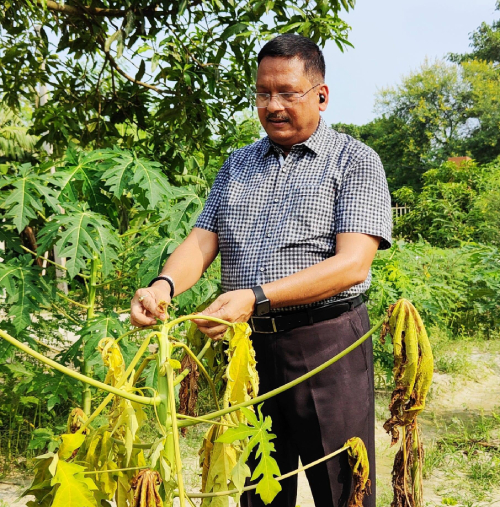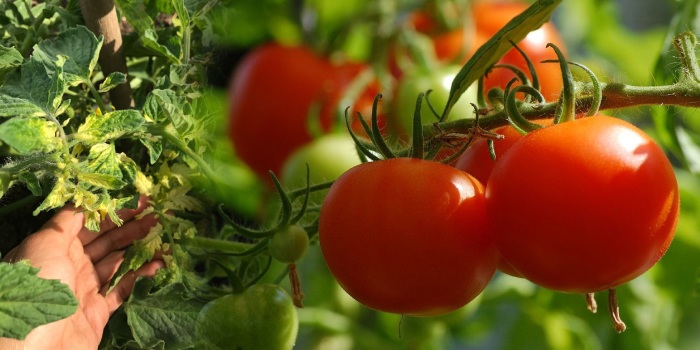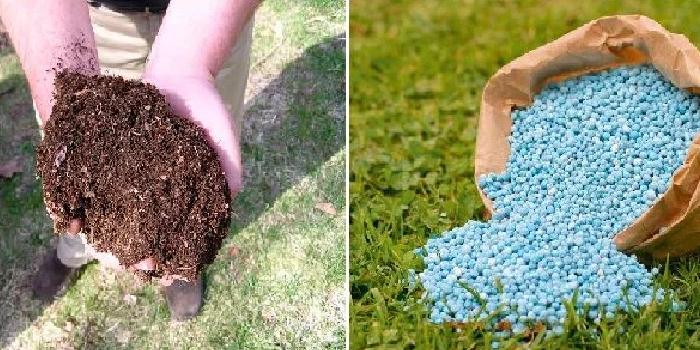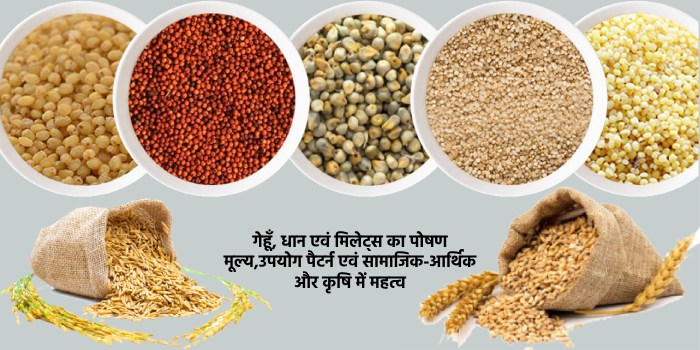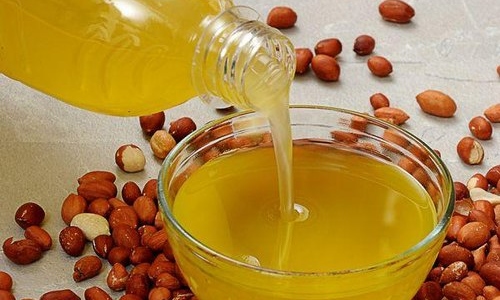
Abstract- Groundnut (Arachis hypogaea L.), is one of the most important oil seed as well as protein rich crop, grown all over the world. The present investigation was carried out for genetic analysis of yield and high oleic acid using allele specific molecular marker in 48 groundnut genotypes. Highly significant and positive correlation was found between number of pods per plant (r=0.399), number of seeds per plant (r=0.575) and harvest index (r=0.400) at 1% significance level. Assessment of high oleic acid content using gene-based markers was done using allele specific markers for FAD2A and FAD2B allele. The UPGMA clustering revealed that12 genotypes forming group with check variety Sunoleic 95R while 35 genotype formed separate groups. In selected lines total protein, oil and fatty acid was estimated using NIR spectroscopy. Total oil was ranging between 46 to 51%, linoleic acid 21 to 49 %, oleic acid 28 to 61%, palmitic acid 9 to 14%, stearic acid 1 to 3%, protein 18 to 31% and moisture level was between 2 to 11% for groundnut seed samples. The highest O/L ratio was in Sunoleic 95R and lowest in GPBD4. Screening of these advance lines and germplasms identified superior breeding material to be used for varietal improvement of groundnut.
Introduction- Groundnut (Arachis hypogaea L.) known as earthnut or peanut or monkey-nut, an allotetraploid (AABB) derived from diploid species Arachis duranensis (AA) and Arachis ipaensis (BB) having 2n=40 pairs of chromosomes. In India, about 81% of the total groundnut produced is used for oil extraction, 12% for seed, 6% for direct consumption and 1% for export trade. Groundnut oil consists of triglycerides (96.1–96.4%), phospholipids (2.4– 2.9%), sterols (0.69–0.80%), free fatty acids (0.1–0.4%) and glycolipids (0.10– 0.14%). Eight fatty acids can be routinely detected in peanut seeds; however, two major fatty acids, oleic acid (C18:1, D9) and linoleic acid (C18:2, D9, D12), account for approximately 80% of the fatty acid composition (Moore et al., 1989, Norden et al., 1987). Major fatty acids in groundnut oil are palmitic acid (8–11%), oleic acid (36– 52%) and linoleic acid (24–43%). The biochemical difference between these two fatty acids is that linoleic acid contains one more double bond at the Δ12 position of the hydrocarbon chain than oleic acid. Fatty acid desaturase (FAD) enzyme facilitates the conversion of oleic acid to linoleic acid by adding double bond to oleic acid (Töpfer et al., 1995). This enzyme is coded by two homologous genes (ahFAD2A and ahFAD2B) located on A and B sub-genomes of groundnut. Consuming oils with high levels of oleic acid is beneficial to human health because it reduces low-density lipoproteins, maintain high-density lipoprotein, slow down atherosclerosis, and reversing the inhibitory effect of insulin production. As a result, groundnut oil with a high percentage of oleic acid is preferred, and the oil quality can be determined by the oleic acid and linoleic acid (O/L) ratio. First groundnut, mutant line, F435 with 80% oleic acid and 2% linoleic acid was reported in 1987 by Norden et al., by applying conventional breeding methods, the first ever high oleate groundnut line, SunOleic 95R (80% oleic acid) was bred in USA (Gorbet et al., 1997). The chemical composition of peanut oil is highly influenced by environmental factors like season, temperature, humidity, geographic location, and growing conditions (Grosso et al., 1994). In general, lower temperature (22˗29°C) is associated with more linoleic acid synthesis due to increased activity of oleate desaturase enzyme (Anderson et al., 2002). High temperature (30˗33°C) during pod filling to harvesting stage reduces the linoleic acid content in peanut oil (Dwivedi et al., 1996, Golombek et al., 1995). Molecular markers play important role in screening of groundnut germplasms for high oleic acid contents due to their polymorphic nature,reproducibility of results and time saving nature (Janilla et al., 2016, Pandey et al., 2014, Pramanik et al., 2019). The linked allele-specific (Chen et al., 2010) and cleaved amplified polymorphic sequences (CAPS) (Chu et al.,2009) markers for both the ahFAD2 genes (ahFAD2A and ahFAD2B) are available for use in molecular breeding. Fatty acid composition of groundnut oil is an important trait from human nutrition point of view as well as oil stability during the storage. Consuming oils with high levels of oleic acid is preferred because oleic acid may be beneficial to human health by reducing lowdensity lipoproteins (LDL), maintaining highdensity lipoproteins (HDL), slowing down atherosclerosis, and reversing the inhibitory effect of insulin production (Vassiliou et al., 2009). Demand of peanut with High Oleicis increasing day by day both in domestic and international markets, so the present study was undertaken with the objectives: Screening of groundnut advance breeding lines and germplasms for yield and its attributes along with leaf area index, marker assisted selection for high oleic acid content.
Materials and Methods- Plant material consisted 48 genotypes were received from Directorate of Groundnut Research, Junagadh, Gujrat. Material consisted7 check groundnut varieties i.e., TG 26, GPBD4, KDG128, ICGS44, Sunoleic95 R, JGN3 and Gangapuri;20 uncharacterized germplasm lines i.e. ICGV 8113, ICGV 13248, ICGV 7996, ICGV 9268, ICGV 9525, ICGV 13231, ICGV 9112, ICGV 13228, ICGV 5647, ICGV 13270, ICGV 13533, ICGV 6673, ICGV 1441, ICGV 13520, ICGV 8059, ICGV 9935, ICGV 13245, ICGV 13552, ICGV 10447, ICGV 9081 and 21 advance breeding lines obtained from the cross ICGV 98432 X ICG 7166 at DGR, Junagadh.
Morpho-physiological Characterization-The field experiment was conducted at research farm of Department of Genetics and Plant Breeding, College of Agriculture, Gwalior during kharif season 2018-19.The sowing was done in Randomized Block Design with two replications. Each entry was grown in two rows having 30 cm row to row and 10 cm plant to plant distance. The yield and its attributing characters via; days to 50% flowering, days to maturity, number of primary branches, number of secondary branches, number of mature pods per plant, pod yield per plant, kernel yield per plant, hundred pod weight, hundred kernel weight, shelling percentage sound mature kernel percent and leaf area were recorded time to time.
Statistical analysis -The analysis of variance (ANOVA) of morphological traits for standard error (S.E.), and coefficient of variation (CV) was performed along with the coefficient of correlation among all the morphological traits using SPSS ver.19 software. The similarity matrices was used to construct a dendrogram for all the genotypes using NTSYS-pc based on UPGMA.
Molecular characterization- PCR amplification and agarose gel electrophoresis Genomic DNA was extracted from young leaf tissue of groundnut by modified CTAB (Cetyl Trimethyl Ammonium Bromide) method (Murray and Thompson 1980; Tiwari et al., 2017). Allele specific primers were used for screening of groundnut germplasm for high oleic acid contents (Chu et al., 2009, Chen et al., 2010) (Table 1). Polymerase Chain Reaction for each allele-specific primer was performed in iCycler ™ system (BIO-RAD, USA). PCR master mix was prepared using genomic DNA of groundnut genotypes(20 ng), 0.5µM forward primer, 0.05µM control reverse primer, 0.45µM allele-specific reverse primer (depending on the target amplicon) and 5 µl polymerase master mix. PCR programming were performed at 94°C for 4 min denaturing temperature, followed by 35 cycles of 94°C for 1 min, 63°C to 66°C (depending on the target primer) for 1 min, and 72°C for 1 min, and then extension at 72°C for 10 min and finally storing at 4°C. For the wild-type fragment F435WT-R (193 bp) was amplified at 63°C annealing temperature. For the fragment (203 bp) containing substitution F435 SUB-R amplification annealing temperature was 64°C while for the fragment (195 bp) containing insertion F435 INS-R the annealing temperature was 66°C.PCR products were resolved on a 2.5% agarose gel stained with ethidium bromide by electrophoresis at 110 V for 2 h. The separated fragment was observed under UV trans-illuminator gel documentation system (UVP Chemidoc). The gel scoring of groundnut genotypes was done on the basis of difference in allele size of amplified bands. The major allele frequency, number of alleles per locus, polymorphism information content (PIC) and gene diversity was analyzed using Power Marker v3.25 software (Liu and Muse, 2005). The dendrogram based on unweighted pair group method for arithmetic average (UPGMA) and bootstrap value of 1000 permutations was constructed using MEGA 6.0 software (Tamura, Dudley, Nei, and Kumar, 2007).
Estimation of nutritional quality- Selected 20 groundnut advance breeding lines and genotypes having higher yield were considered for taking observations on various qualitative traits. Protein, fatty acid and oil concentration were measured with near‐ infrared reflectance spectroscopy (NIRS) (NIR Systems model XDS monochromator, FOSS Analytical AB, Sweden, Denmark) at ICRISAT, Hyderabad. About 100-150 seeds of each groundnut genotype were scanned twice using NIRS. Calibration equations were developed in the laboratory and validated for estimation of oil, protein and fatty acid concentration in groundnut seeds (Unpublished data).
Results and Discussion- Morphological characterization Range value for days to 50% flowering was between 24 to 35, days to maturity between 97 to 110 days, number of primary branches was between 4 to 7, number of secondary branches 4 to 8, sound mature karnel 61 to 89, hundred karnel weight 34 to 56, hundred pod weight 78 to 102 and karnel yield per plant was 62 to 72 gm. The coefficient of correlation among different traits was analyzed using SPSS ver. 19 software at 1% and 5%, significant level respectively (Table 3). Significant and positive correlation was found between days to 50 % flower and days to maturity (r=0.353), and grain yield (r=0.369) at 5% significance level (Table 2). Highly significant and positive correlation was found between number of pods per plant (r=0.399), number of seeds per plant (r=0.575) and harvest index (r=0.400) at 1% significance level. The number of branches per plant was highly significant with number of pods per plant (r=0.635) and number of seed per plant (r=0.556) at 1% significance level. Mean value of all the observed morphological traits was considered for phylogenetic analysis using NTSYS ver.2.0 software. All the genotypes are grouped into two major clusters EI and EII containing 42 and 6 genotypes, respectively. The clusters are further subclustered showing similar characters. The six germplasm ICGV 7996, ICGV 13533, ICGV 13520, ICGV 6673, ICGV 9525 and ICGV 5647 show distinct characteristics and not having any of the check varieties (Fig. 1). The 2D plot formed between kernel yield per plant and 100 pod weight (Fig. 2) as these two traits are major yield contributing characters. The 2D plot formed 4 clusters and SUNOLEIC 95R grouped in cluster II. Check varieties TG 26, KDG128and Sunoleic 95R are forming same group with high oleic acid advance lines (AOL) and 3 germplasm ICGV 13248, ICGV 8003 and ICGV 9268 showing similar morphological characters.
Marker assisted selection for high oleic acid content in groundnut A set of 6 primers specific for oleic acid contents were selected for validation of groundnut germplasms. Out of them 4 markers i.e., F435-SUB F435-INS, FAD2B-F + FAD2- R, FAD2B-F + FAD2B-A + FAD2-R generated polymorphic bands. These validated markers were selected for the further studies and screening of grounndut genotypes for high oleic acid contents. The gene diversity and Polymorphic Information Contents (PIC) value ranges between 0.49-0.65 and 0.37-0.58 respectively (Table 4). A total of 13 alleles were osberved and number of alleles per locus was 2 to 4. The CAPS marker FAD2B-F + FAD2-R shows higher genetic diversity (0.4167) and PIC value (0.5817), where as the SSR primer F435-INS reveals lowest gene diversity (0.5417) and PIC value (0.3733). The major allele frequency for FAD2B-F + FAD2-R was observed 0.4167 which is lowest; while primer F435-SUB evident highest major gene frequency (0.6042) (Table 4). The 15 unknown germplasm and one high oleic acid line shows amplification with F435-F, F435IC-R, and F435WT-R at 193 bp was amplified. out of 48 taregeted genotypes 21 shows band pairing with F435-F, F435IC-R, and F435-SUB primer at 203 bp amplification. The primer combination F435-F, F435IC-R, and F435-INS amplified in JGN-3 cultivar, 6 high oleic acid lines and 13 unknown germplasm; giving product size 195 bp.The CAPS markers combination FAD2B-F + FAD2-R and FAD2B-F + FAD2B-A + FAD2- R amplifies the B-genome. The genetic relationships among groundnut advance breeding lines and germplasms are presented based on Unweighted Neighbor Joining (UNJ) dendrogram (Fig. 3). All the genotypes were grouped into five major clusters. The advance breeding line AOL 9 was distinct and not grouped with any of the clusters. Cluster I contain 4 germplasms, while 3 germplasm and one advance breeding line were grouped in cluster II including JGN 3, one of the major variety of Madhya Pradesh state. Cluster III was having 4 germplasms and 2 AOL, while cluster IV grouped with 3 germplams, 4 AOL and 3 check varieties including TG 26, GPBD 4 and Gangapuri. Cluster V formed group with sunoleic 95 R, KDG 128, 10 AOLs and one germplasm ICGV 9081 while cluster VI grouped with 3 AOLs and 4 groundnut germplasms.
Nutritional Quality Traits Analysis Oil, fatty acid profiles and proteinpercentage was analysed in selected high yielding genotypes of groundnut. Highest oil i.e., 57% was found for AOL 6 and lowest for JGN 3 (46%). Oleic acid was ranged between 62 to 29.7 % for sunoleic 95 R and GPBD 4 respectively, linolic acid between 22 to 49 % for GBPD4 and Sunoleic 95 R respectively. Palmitic acid was ranging between 10.22 (sunoleic 95 R) to 14.07% (Gangapuri), stearic acid 1.05 (AOL3) to 3.27 (Gangapuri) (Fig. 4, Table 4). Groundnut varieties with high oleic/linoleic acid ratios (O/L) have become preferred by the peanut industry due to their increased shelf life and improved health benefits. O/L ratio was ranged from 2.78 to 0.59. Sunoleic 95 R variety was represented highest O/L ratio (Fig. 5). Cluster analysis based on diversity was performed using the UPGMA (Fig. 6). The mean value of fatty acids for groundnut variety falling in each cluster was presented in the generated dendrogram for distinguished into two clusters (I, and II). Cluster I consisted two varieties viz. Sunoleic 95 R and AOL-3. Sunoleic 95 R exhibited highest oleic content while AOL-3 lowest stearic acid content. Cluster II further divided into two sub cluster and consited 18 variety of ground nut. Principal component analysis (PCA) was done by considering four variables viz. Linoleic acid, oleic acid, palmitic acid and Stearic acid simultaneously. The pattern of variations illustrated by the PCA described by correlation coefficients determined for pair-wise association of the traits (Fig. 7). The PCA correlation depicted that which variety possessed higher and lower fatty acid content occupying unique position towards the graph. The variety Sunoleic 95 R came as out group showing the maximum diversity. Total protein was ranging between 18.5 % to 31.68 % for ICGV 7996 to AOL 18 respectively. Moisture level was between 2.9 to 11.4 for AOL 3 and ICGV 8059 respectively (Table 4). Peanut with high oleic acid is preferred over normal peanut due to its multiple health benefits, extended shelf life and for industrial purposes. Therefore, screening of groundnut germplasm for high oleic acid contents and its utilization for improvement of peanut for higher oxidative stability and better dietary properties is one of the important breeding objectives worldwide.



